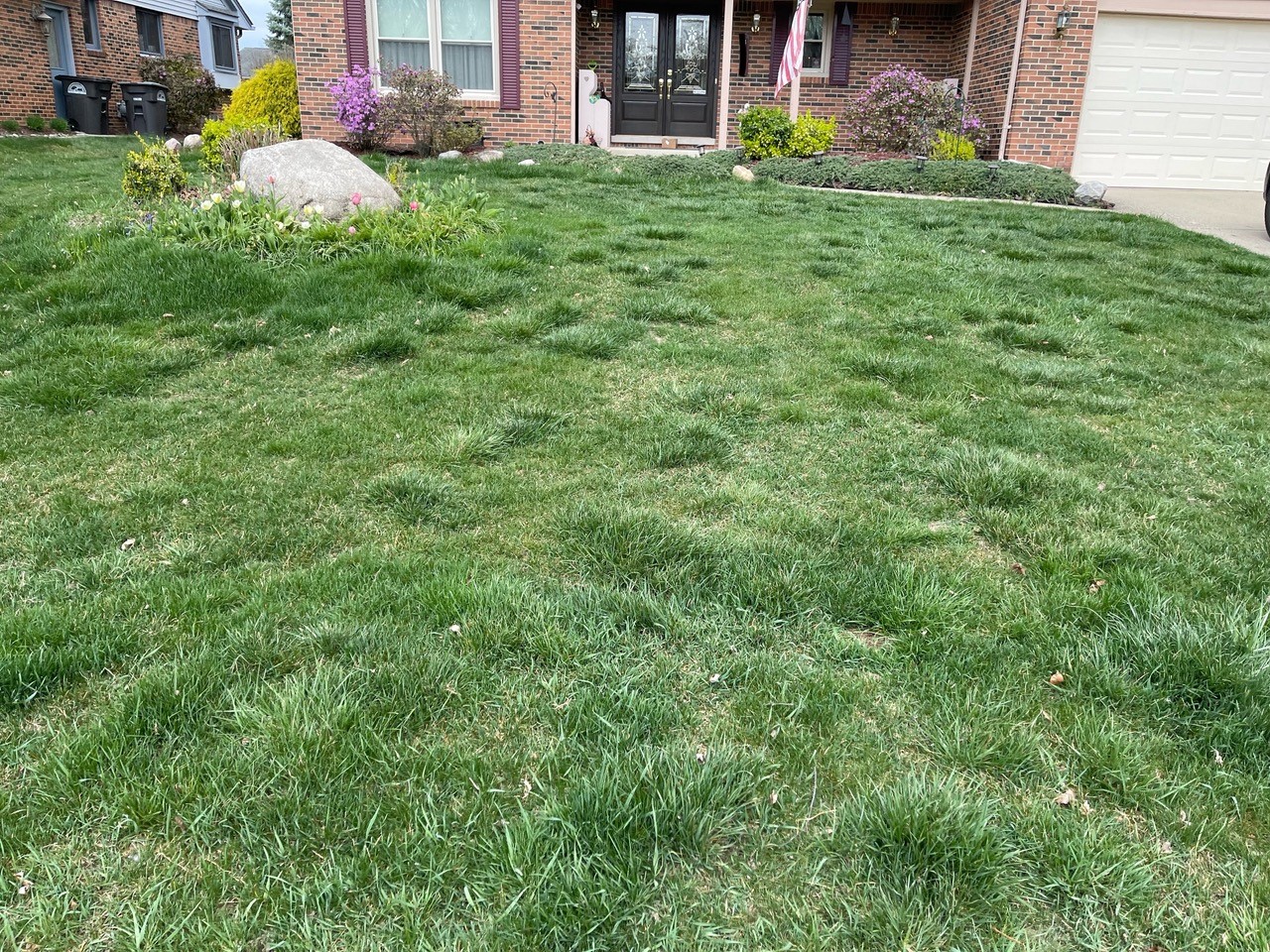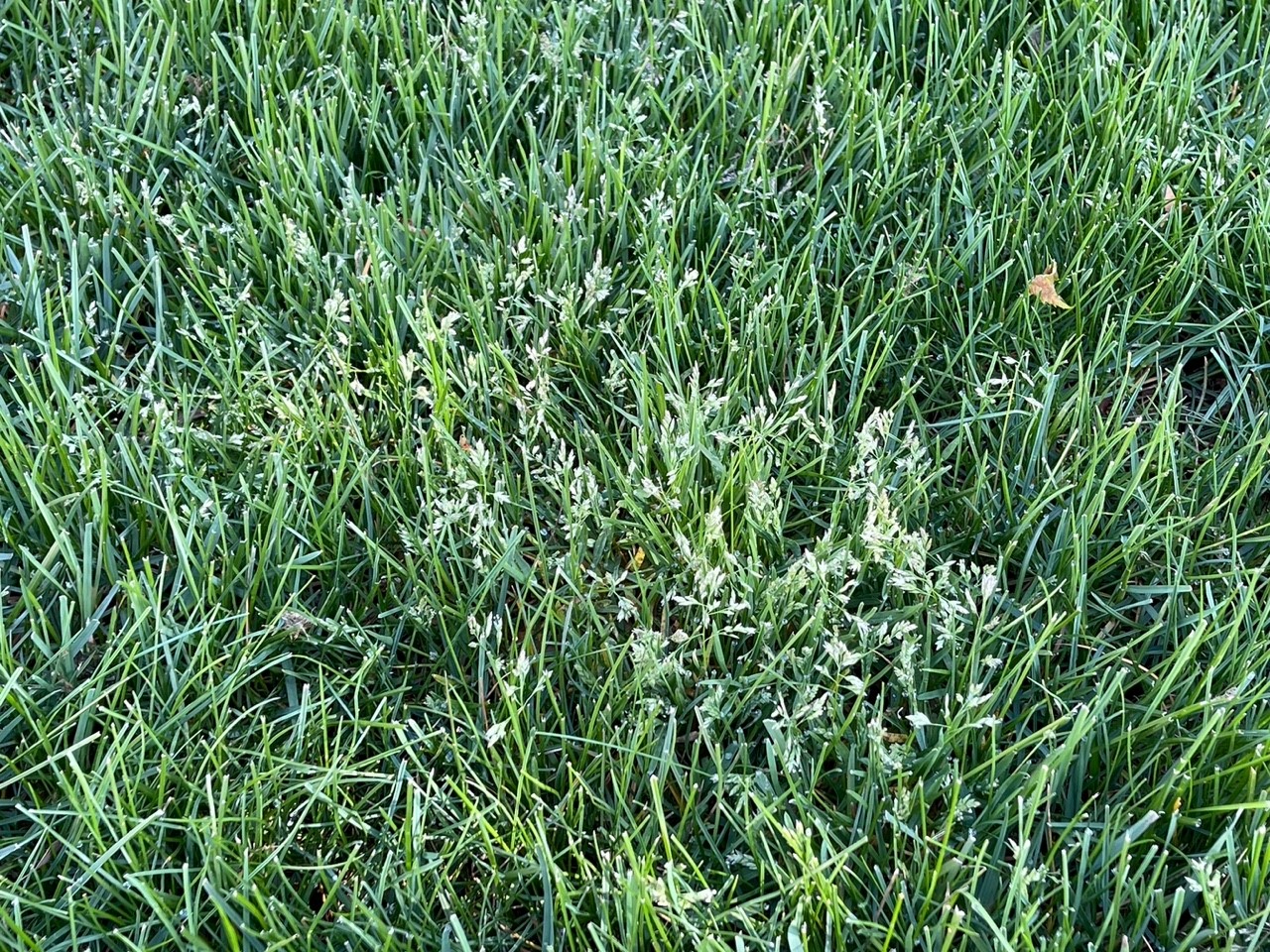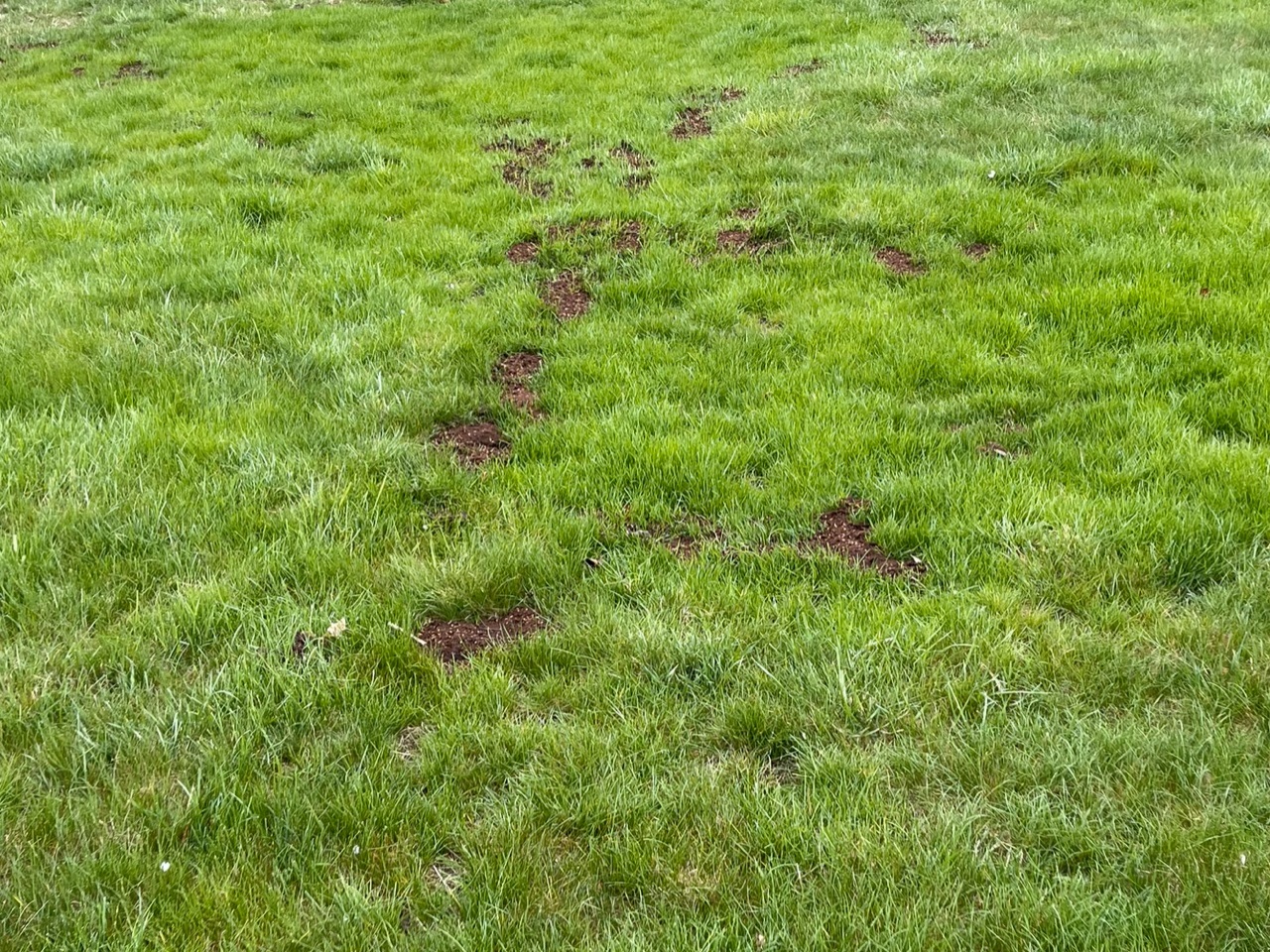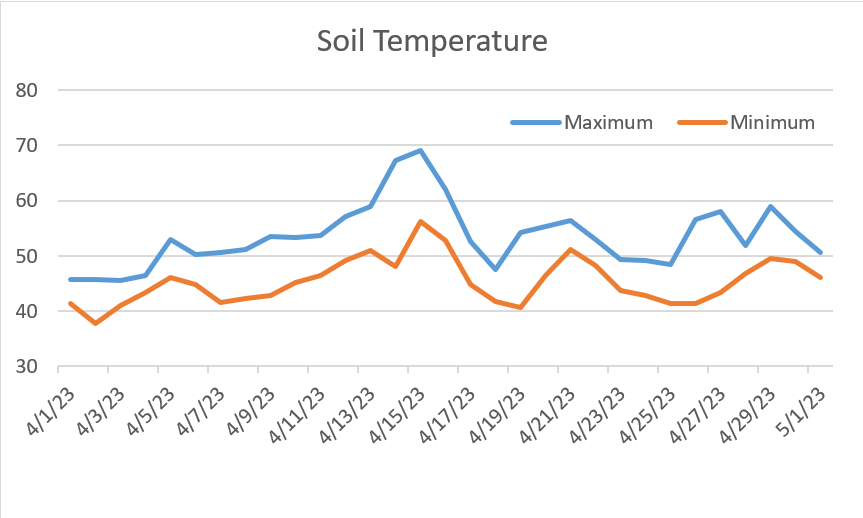Lawn turf update - May 4, 2023
Lawns have been slow growing this spring with the unusually cold and wet weather but the forecasted warmup by the end of the week will have lawns and weeds springing to life.

Mowing conditions
Spring always seems to create challenging mowing conditions and this year was no different. From poor mower setup to mowing through soaking wet turf, mistakes this time of year can lead to problems for the rest of the year. Mowing through wet conditions is not only aesthetically problematic due to mud tracking, but the ruts created and turf ripped from stopping, starting and turning will be with you for weeks if not months to come. It’s better to just skip a mowing than create these problems to try to stay on schedule.
Another trend I’ve noticed this spring is for homeowners to mow the lawn especially short, to the point of scalping. Scalping is a term used to describe excessively short mowing that removes an excessive amount of leaf tissue, resulting in a tan or light yellow color due to exposed stems, dead leaves and even soil. I’m not sure if this is an effort to try and even out the nonuniform growth in lawns or simply the “if I mow it short, I won’t have to mow for a while” attitude.

The lack of uniform turf growth is often due to different turfgrass species or cultivars growing at different rates when temperatures are cold. Scalping at this time of year could enhance crabgrass infestation later this summer as scalping slows turf growth and the opened canopy results in faster soil heating, which translates to crabgrass germination even sooner than expected.
Since it’s May and we’re talking about mowing, we must mention the “No Mow May” campaign. This effort started in the United Kingdom with good intentions of enhancing or improving conditions for pollinators. Sara Stricker and Eric Lyons from the Guelph Turfgrass Institute in Ontario, Canada, recently wrote an excellent summary of “No Mow May” and its shortcomings.
Their article makes these several points:
First, the research that was originally cited as evidence to support “No Mow May” has been retracted in the last year due to flaws in the research design and conclusions.
Second, there is debate about the value of common flowering weeds in lawns this time of year, primarily dandelions, being a valuable source of nutrition for bees.
Third, skipping mowing in May is going to result in excessive top growth that is going to be challenging to manage once mowing resumes in June. Trying to mow down top growth that may be three to four times the normal mowing height will be difficult with typical home lawn mowers and will create excessive clippings that will need to be collected from the lawn.
Michigan State University Extension offers many resources for understanding pollinators in lawns and gardens, including information on flowering bee lawns that will likely have a greater impact on protecting pollinators and enhancing pollinator habitat rather than taking a month off from mowing lawns.
Seedheads in lawns

The common lawn grasses – Kentucky bluegrass, perennial ryegrass, fine leaf fescue and tall fescue – all produce seedheads as do grassy weeds such as annual bluegrass (Poa annua). Currently, we are seeing peak seedhead production for annual bluegrass. Annual bluegrass generally appears in patches in lawns and at this time of year the seedheads make it even more obvious. There are options for trying to control annual bluegrass in lawns but none of them are easy and generally require multiple applications, often with limited results.
Seedhead production from Kentucky bluegrass and other common lawn grasses varies greatly by cultivar with some producing very few if any seedheads and others being prolific seedhead producers. Seedhead production requires energy from the plant, so it is likely the turf will not only look stemmy due to the seed stalks, but the turfgrass may even lose density during and after seeding.
Consider a fertilizer application following the seedhead flush to help the turf recover, especially if you haven’t fertilized yet this spring or fertilized back in early April. Keep the mower blade sharp to ensure a clean cut and don't lower the mowing height to try and remove seedheads. Annual bluegrass produces seedheads below the 0.125-inch mowing height on golf course putting greens, so lowering the mowing height is not going to eliminate seedheads from your lawn.
Dandelions
Dandelions are in peak flower right now in many areas. I’m not going to debate the merits of dandelions in this article. Some might want to make dandelion wine, some may want to add them to their salad, and some may want to get rid of them. If you like the color or have an alternate use for dandelions, please stop reading as in the next paragraph I’ll discuss control options.
There are at least a couple different strategies for controlling dandelions. Applications during flowering and prior to the puff-ball stage can be effective at burning down the rosette and preventing puff-balls, i.e. more dandelion seed. Herbicide applications at the puff-ball stage can be very effective as this is the time the dandelion is at its weakest because it has just spent all that energy pushing out flowers.
Winter annuals and difficult to control broadleaf weeds
In addition to dandelions, many other broadleaf weeds are beginning to flower. Common chickweed, henbit, shepherd’s purse, yellow rocket, corn speedwell, wild violet and ground ivy are all flowering. All but wild violet and ground ivy are winter annuals. The life cycle of a winter annual is they germinate in the fall, overwinter and then flower and produce seed in the spring. After flowering in the spring, winter annuals are usually only two to three weeks from dying. If you apply herbicides, they will be dead and gone in two to three weeks and if you do nothing, they will be dead and gone in two to three weeks. Get it? Erin Hill and Angela Tenney from MSU’s Plant and Pest Diagnostics recently wrote an excellent article on winter annual identification and management.
Tough to control perennial broadleaf weeds such as ground ivy (also known as creeping Charlie), wild violet, germander and creeping speedwell are currently flowering. The flowering period is the best chance to kill them besides fall. The typical broadleaf combination herbicide containing 2,4-D provides fair control at flowering but if you can find combination herbicides with the active ingredients quinclorac, triclopyr, fluroxypyr or carfentrazone, you should achieve better than fair control. As with any pesticide application, be sure to read and follow all labeled instructions.
Spring seeding

Maybe sots of your lawn died last summer; maybe spots were killed from deicing salt, dog spot or snow mold over the winter. Regardless of the cause, seeding dead areas in lawns is common this time of year. In the next several weeks as temperatures warm, there might be some areas that see renewed grub feeding. If you’re reseeding following grub damage, wait about one to two weeks after applying a grub insecticide before reseeding.
For all reseeding, it is safe to apply fertilizer at the time of seeding. For new establishment, a starter fertilizer is recommended. Starter is a fertilizer that has a nitrogen to phosphorus ratio of 1:1 or 1:1.5. A starter fertilizer application at seeding will prove beneficial in getting the young turf seedlings going. Application rates for a starter fertilizer at seeding are approximately 1 pound nitrogen (N) per 1,000 square feet. Starter fertilizer for new establishment is permitted under Michigan’s fertilizer act. Make sure to follow label directions, contain all fertilizer on the area to be seeded and off the driveway, and keep a minimum of 15 feet from any surface water.
Keep the seeded area moist throughout establishment. Depending on what Mother Nature supplies, a new seeding may require watering several times a day. A good mulch cover will help the area stay moist so the site may be watered less frequently. Water lightly when irrigating; there is no need to see water standing or running off the site.
Avoid applying herbicides this spring, i.e., no fertilizer plus crabgrass preventer or weed and feed products. Young seedlings don’t tolerate herbicides very well and the guideline is usually to wait three "real" mowings before applying any herbicides, or in some cases at least 60 days. Real mowings mean you’re actually cutting grass, not just running over the area to trim down any weeds.
Don’t give up on those April seedings just yet. Except for the week of April 9, temperatures were cold and seed germination and emergence were very slow. Soil temperatures peaked at the Hancock Turf Research Center in East Lansing, Michigan, on April 15 (Figure 1) and have since crashed. Be patient, the forecast looks good and hopefully these areas will now start to see additional emergence and the green fuzz on the surface that signifies success will appear.




 Print
Print Email
Email
